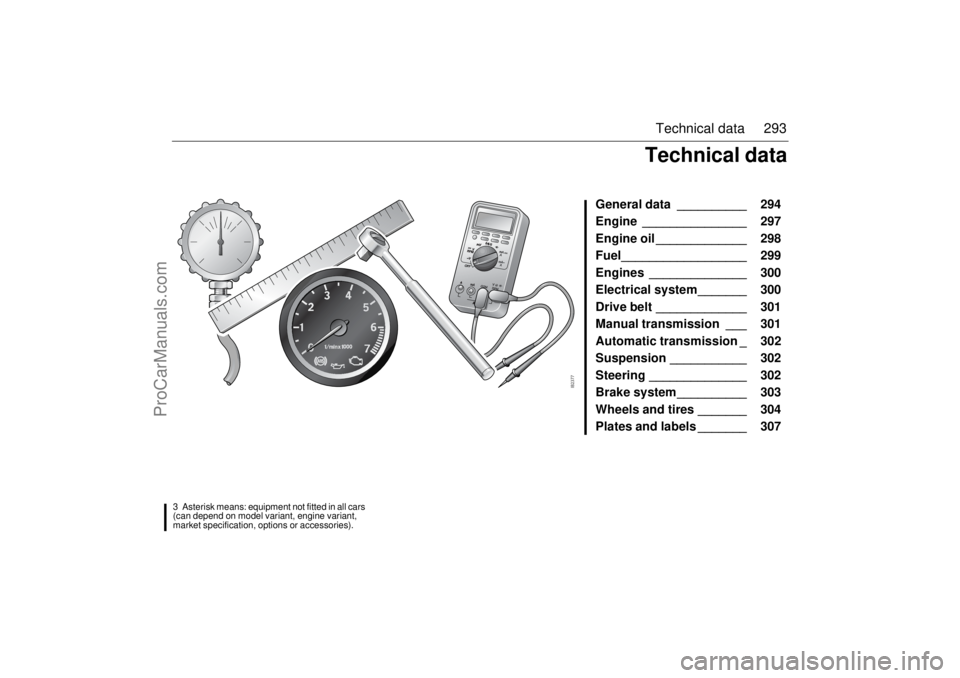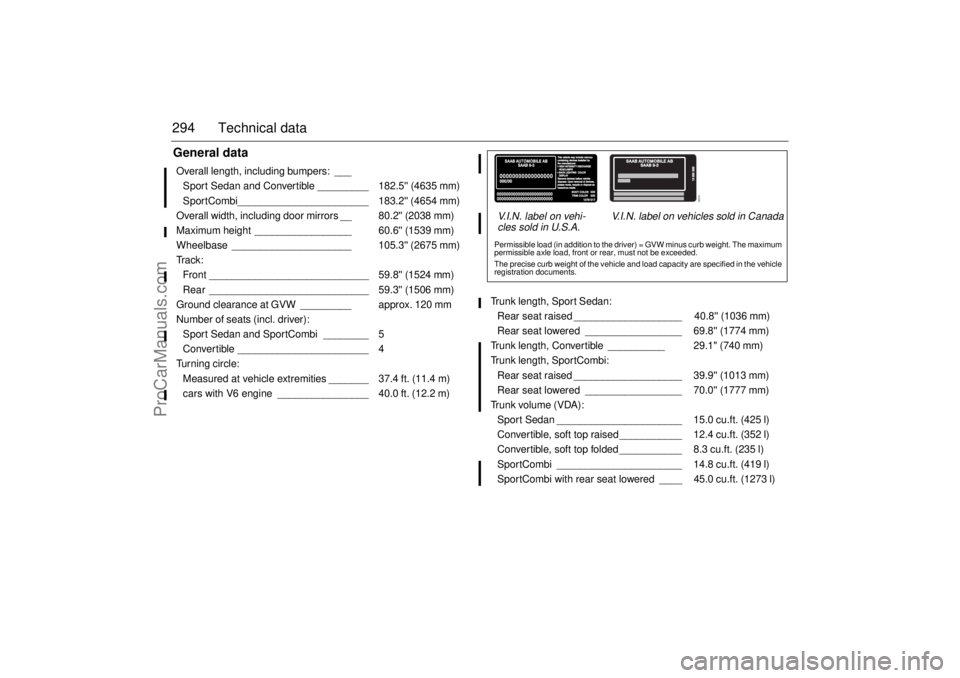SAAB 9-3 2006 Owners Manual
Manufacturer: SAAB, Model Year: 2006, Model line: 9-3, Model: SAAB 9-3 2006Pages: 318, PDF Size: 28.05 MB
Page 291 of 318

291 Customer Assistance and Information
Reporting Safety
Defects (USA)If you believe that your vehicle has a defect
which could cause a crash or could cause
injury or death, you should immediately
inform the National Highway Traffic Safety
Administration (NHTSA) in addition to noti-
fying Saab Cars USA, Inc.
If NHTSA receives similar complaints, it
may open an investigation, and if it finds that
a safety defect exists in a group of vehicles,
it may order a recall and remedy campaign.
However, NHTSA cannot become involved
in individual problems between you, your
dealer, or Saab Cars USA, Inc.
To contact NHTSA, you may either call the
Auto Safety Hotline toll-free at 1-800-424-
9393 (or 202/366-0123 in Washington D.C.
area) or write to: NHTSA, U.S. Department
of Transportation, Washington, D.C. 20590.
You can also obtain other information about
motor vehicle safety from the Hotline.
Reporting Safety
Defects to the Canadian
governmentIf you live in Canada, and believe that your
vehicle has a safety defect, you should
immediately notify Transport Canada, in
addition to notifying General Motors of
Canada Limited.
You may write to Transport Canada at Box
8880, Ottawa, Ontario, K1G 3J2.
In addition to notifying Transport Canada in
a situation like this, we certainly hope you
will notify us. In Canada, please call our
Saab Customer Assistance Centre at 1-
800-263-1999.
Or write:
General Motors of Canada Limited
Customer Assistance Centre,
1908 Colonel Sam Drive,
Oshawa, Ontario, L1H 8P7.
93U S M 06.book Page 291 Friday, February 18, 2005 1:15 PM
ProCarManuals.com
Page 292 of 318

292 Customer Assistance and InformationVehicle Data Collection and
Event Data RecordersYour vehicle, like other modern motor vehi-
cles, has a number of sophisticated com-
puter systems that monitor and control sev-
eral aspects of the vehicle’s performance.
Your vehicle uses on-board vehicle comput-
ers to monitor emission control components
to optimize fuel economy, to monitor condi-
tions for air bag deployment and, if so
equipped, to provide anti-lock braking and
to help the driver control the vehicle in diffi-
cult driving situations. Some information
may be stored during regular operations to
facilitate repair of detected malfunctions;
other information is stored only in a crash
event by computer systems commonly
called event data recorders (EDR).
In a crash event, computer systems, such
as the Air Bag Sensing and Diagnostic
Module (SDM) in your vehicle may record
information about the condition of the vehi-
cle and how it was operated, such as data
related to engine speed, brake application,
throttle position, vehicle speed, steering
wheel angle, lateral acceleration, safety belt
usage, air bag readiness, air bag perfor-
mance, and the severity of a collision. This
information has been used to improve vehi-
cle crash performance and may be used to
improve crash performance of future vehi-
cles and driving safety. Unlike the data
recorders on many airplanes, these on-
board systems do not record sounds, such
as conversation of vehicle occupants.To read this information, special equipment
is needed and access to the vehicle or the
SDM is required.
Saab will not access information about a
crash event or share it with others other than
with the consent of the vehicle owner or, if
the vehicle is leased, with the consent of
the lessee,
in response to an official request of police
or similar government office,
as part of Saab’s defense of litigation
through the discovery process, or
as required by law.
In addition, once Saab collects or receives
data, Saab may
use the data for Saab research needs,
make it available for research where
appropriate confidentiality is to be main-
tained and need is shown, or
share summary data which is not tied to a
specific vehicle with non-Saab organiza-
tions for research purposes.
Others, such as law enforcement, may have
access to the special equipment that can
read the information if they have access to
the vehicle or SDM.
If your vehicle is equipped with OnStar®,
please check the OnStar® subscription ser-
vice agreement or manual for information
on its operations and data collection.93U S M 06.book Page 292 Friday, February 18, 2005 1:15 PM
ProCarManuals.com
Page 293 of 318

293 Technical data
General data __________ 294
Engine _______________ 297
Engine oil _____________ 298
Fuel__________________ 299
Engines ______________ 300
Electrical system_______ 300
Drive belt _____________ 301
Manual transmission ___ 301
Automatic transmission _ 302
Suspension ___________ 302
Steering ______________ 302
Brake system__________ 303
Wheels and tires _______ 304
Plates and labels _______ 307
Technical data
3Asterisk means: equipment not fitted in all cars
(can depend on model variant, engine variant,
market specification, options or accessories).93U S M 06.book Page 293 Friday, February 18, 2005 1:15 PM
ProCarManuals.com
Page 294 of 318

294 Technical dataGeneral dataOverall length, including bumpers: ___
Sport Sedan and Convertible _________ 182.5'' (4635 mm)
SportCombi_______________________ 183.2'' (4654 mm)
Overall width, including door mirrors __ 80.2'' (2038 mm)
Maximum height _________________ 60.6'' (1539 mm)
Wheelbase _____________________ 105.3'' (2675 mm)
Tr a c k :
Front ____________________________ 59.8'' (1524 mm)
Rear ____________________________ 59.3'' (1506 mm)
Ground clearance at GVW _________ approx. 120 mm
Number of seats (incl. driver):
Sport Sedan and SportCombi ________ 5
Convertible _______________________ 4
Turning circle:
Measured at vehicle extremities _______ 37.4 ft. (11.4 m)
cars with V6 engine ________________ 40.0 ft. (12.2 m)
V.I.N. label on vehi-
cles sold in U.S.A.V.I.N. label on vehicles sold in CanadaPermissible load (in addition to the driver) = GVW minus curb weight. The maximum
permissible axle load, front or rear, must not be exceeded.
The precise curb weight of the vehicle and load capacity are specified in the vehicle
registration documents.Trunk length, Sport Sedan:
Rear seat raised ___________________ 40.8'' (1036 mm)
Rear seat lowered _________________ 69.8'' (1774 mm)
Trunk length, Convertible __________ 29.1" (740 mm)
Trunk length, SportCombi:
Rear seat raised ___________________ 39.9'' (1013 mm)
Rear seat lowered _________________ 70.0'' (1777 mm)
Trunk volume (VDA):
Sport Sedan ______________________ 15.0 cu.ft. (425 l)
Convertible, soft top raised ___________ 12.4 cu.ft. (352 l)
Convertible, soft top folded ___________ 8.3 cu.ft. (235 l)
SportCombi ______________________ 14.8 cu.ft. (419 l)
SportCombi with rear seat lowered ____ 45.0 cu.ft. (1273 l)
93U S M 06.book Page 294 Friday, February 18, 2005 1:15 PM
ProCarManuals.com
Page 295 of 318

295 Technical data
Curb weight
(i.e. with full fuel tank, full washer fluid res-
ervoir, standard tools and spare wheel):
Sport Sedan ______________________ 3200–3420 lbs.
(1450–1550 kg)
Convertible _______________________ 3570–3700 lbs.
(1620–1680 kg)
SportCombi_______________________ xx
Gross vehicle weight (GVW):
Sport Sedan ______________________ 4120–4340 lbs.
(1870–1970 kg)
Convertible _______________________ 4460–4520 lbs.
(2025–2050 kg)
SportCombi_______________________ xx
Maximum axle load:
Sport Sedan, front _________________ 2480 lbs. (1125 kg)
Sport Sedan, rear __________________ 2230 lbs. (1010 kg)
Convertible, front __________________ 2540 lbs. (1150 kg)
Convertible, rear ___________________ 2310 lbs. (1050 kg)
SportCombi_______________________ xx
SportCombi_______________________ xx
Weight distribution:
Curb weight + driver (150 lbs. (68 kg)),
front/rear, Sport Sedan and SportCombi approx. 60/40 %
GVW, front/rear, Sport Sedan and Sport-
Combi ___________________________ approx. 50/50 %Maximum roof load, Sport Sedan and Sport-
Combi ________________________ 220 lbs. (100 kg)
Maximum load in trunk, Sport Sedan, Con-
vertible and SportCombi __________ 175 lbs. (80 kg)
The combined weight of occupants and
cargo should never exceed:
Sport Sedan and SportCombi ________ 925 lbs. (420 kg)
Convertible _______________________ 775 lbs. (352 kg)
Maximum combined weight of driver and
passengers ___________________
Sport Sedan and SportCombi
(5x150 lbs.)_______________________ 750 lbs. (340 kg)
Convertible (4x150 lbs.) _____________ 600 lbs. (272 kg)93U S M 06.book Page 295 Friday, February 18, 2005 1:15 PM
ProCarManuals.com
Page 296 of 318

296 Technical data
WARNING
The GVW and maximum axle loads must not be exceeded.
Note that if some accessories (e.g. towbar, CD changer) are
fitted, the available load capacity is reduced by the weight of
these.
When carrying a load in the trunk, make sure that it is lashed
down securely, particularly when part or all of the rear seat is
folded down.
Trailer:
Trailer with brakes ________________ Max. 3500 lbs.
(1588 kg)
Trailer without brakes _____________ Max. 1000 lbs.
(450 kg)
Recommended towball load ________ 110–165 lbs.
(50–75 kg)
See also page 200.
Maximum theoretical towing speed, trailer
with brakes ____________________ 60 mph (100 km/h)
When towing a trailer, increase the pressure
of the rear tires by 20 kPa (3 psi).
The above speed and weight restrictions are those specified by
Saab Automobile AB.
Note that national restrictions may apply to trailer speeds and
weights (see page 198).
93U S M 06.book Page 296 Friday, February 18, 2005 1:15 PM
ProCarManuals.com
Page 297 of 318

297 Technical data
EngineTy p e :
Petrol engine, 4-cyl. ________________ Four cylinders,
double overhead
camshafts,
16 valves, two
balancer shafts
Petrol engine, V6 __________________ Six cylinders,
4 overhead cam-
shafts, 24 valves,
the angle between
the cylinder rows is
60°
Cylinder bore:
Petrol engine, 4-cyl. ________________ 3.386'' (86 mm)
Petrol engine, V6 __________________ 3.504'' (89 mm)
Stroke:
Petrol engine, 4-cyl. ________________ 3.386'' (86 mm)
Petrol engine, V6 __________________ 2.945'' (74.8 mm)
Swept volume:
Petrol engine, 4-cyl. ________________ 122 cu.in. (1.998 l)
Petrol engine, V6 __________________ 170 cu.in. (2.792 l)Idling speed ____________________ 720 rpm.
When the engine
load increases, e.g.
the steering wheel
is turned, the idling
speed is raised to
900 rpm.
Antifreeze ______________________ Saab-approved
antifreeze
Coolant capacity:
Petrol engine, 4-cyl. ________________ 7.5 qts. (7.1 l)
Petrol engine, V6 __________________ 9.5 qts. (9.0 l)93U S M 06.book Page 297 Friday, February 18, 2005 1:15 PM
ProCarManuals.com
Page 298 of 318

298 Technical dataEngine oilTo meet demands in Saab's extended service intervals all en-
gines are filled with specially designed synthetic factory fill oils.
Long service intervals, fuel economy and environmental issues
are the base for our choice of oil. By using oils approved by
Saab you minimise the tendencies for oil sludge build, by that
protecting the engine from harmful, wear increasing, deposits.
Approved oils:
For all gasoline engines - fully synthetic engine oil - approved
against the GM-LL-A025 specification - with viscosity SAE 0W-
30 or 0W-40. To benefit from Saab´s specified service intervals,
pleasure ensure to select a fully synthetic engine oil approved
against GM-LL-A025.
For optimum performence Saab recommends the use of Saab
Long Life Turbo Oil 0W-30 or Mobil 1 0W-40 European Car For-
mula, but other fully synthetic oils approved against the above
specification and with proper SAE viscosity 0W-30 or 0W-40
may also be used.Servicing/Oil changes:
To be able to use recommended service intervals the need to
use only approved engine oils is vital. Use only engine oils ap-
proved for your engine. Service should be done according to
the recommended service intervals to optimize your engine's
function through out its entire life. Saab Automobile AB will not
take responsibility for any damage that might occur due to ne-
glecting to meet above mentioned requirements.
At your Saab dealers you can find Saab Genuine or Mobil en-
gine oils. Among those there are oils specially designed to meet
your engines specific needs. We recommend that you, with the
help of our skilled service personnel, choose your oil from that
selection.
Other oil companies also offer engine oils approved against GM
specifications. Oils meeting these standards may be marked as
synthetic. However, not all synthetic engine oils will meet your
engines specific requirements. Please ensure only to use fully
synthetic oils approved against your engines specific require-
ments, i.e. GM-LL-A025 with viscosity SAE 0W-30 or SAE 0W-
40.
Recommended oil viscosities.
Viscosity is a measurement of the oil´s thickness at various
temperatures, according to the SAE standard. The thickness in-
fluences e.g. fuel economy and cold starting properties. For op-
timum performance Saab recommends:
For gasoline engines:
SAE 0W-30 or SAE 0W-40 engine oil.
Extra engine oil additives.
Don't add anything to your oil. The recommended oils are all
you will need for good engine performance and protection.
93U S M 06.book Page 298 Friday, February 18, 2005 1:15 PM
ProCarManuals.com
Page 299 of 318

299 Technical data
Fuel
When to change engine oil.
Your vehicle has a display (SID) where time for service will be
shown. Based not only on mileage but also on driving condi-
tions the mileage at which a service will be indicated can vary
considerably.
Under normal circumstances the service indication will come on
at or around 15 000 miles or 2 years.
For this service system to work it is of outmost importance that
the right engine oil is used.
When the message for service is displayed you need to have
the required service done as soon as possible.
After the service your service personnel will reset the service in-
dicator. It is important to reset the service indicator in order to
optimize the time to the next service.
Oil capacity, including filter (oil change)
Petrol engine, 4-cyl. ________________ 6.3 qts. (6.0 l)
Petrol engine, V6 __________________ 6.0 qts. (5.7 l)Fuel tank capacity ________________ 16.05 U.S. gal. (61 l)
For optimum performance Saab recom-
mends: _______________________ 2.0t 175 hp – AON 90.
2.0T 210 hp – AON 90.
2.8 V6 230 hp and
250 hp — AON 90.
Gasoline with a lower octane rating can be used, although not
lower than AON 87. However, engine performance will fall slightly
and heavy loading and laboring should be avoided. For optimum
performance, use the recommended grade of fuel.
For further information on fuel, see page 169.93U S M 06.book Page 299 Friday, February 18, 2005 1:15 PM
ProCarManuals.com
Page 300 of 318

300 Technical dataEngines Electrical system2.0t EcopowerRating, EEC at 5500 rpm ____________ 175 hp (129 kW)
Maximum torque, EEC at 2500 rpm ____ 195 ft.lb. (265 Nm)
Compression ratio__________________ 9.5:12.0T EcopowerRating, EEC at 5300 rpm ____________ 210 hp (155 kW)
Maximum torque, EEC at 2500 rpm ____ 221 ft.lb. (300 Nm)
Compression ratio__________________ 9.5:12.8 V6 (230) EcopowerRating, EEC at 5500 rpm ____________ 230 hp (169 kW)
Maximum torque, EEC at 2250 rpm ____ 243 ft.lb. (330 Nm)
Compression ratio__________________ 10.0:12.8 V6 (250) EcopowerRating, EEC at 5500 rpm ____________ 250 hp (184 kW)
Maximum torque, EEC at 2250 rpm ____ 257 ft.lb. (350 Nm)
Compression ratio__________________ 10.0:1Voltage ________________________ 12 V
Battery capacity _________________ 60 Ah
Starter motor:
Petrol engine, 4-cyl. ________________ 1.8 kW
Petrol engine, V6 __________________ 1.4 kW
Alternator rating:
4-cyl. with manual gearbox ___________ 120 A/14 V
4-cyl. with automatic gearbox _________ 140 A/14 V
V6 engine ________________________ 155 A/14 V
Firing order _____________________
Petrol engine, 4-cyl. ________________ 1-3-4-2
Petrol engine, V6 __________________ 1-2-3-4-5-6
Spark plugs:
Petrol engine, 4-cyl.
Type ____________________________ NGK PFR6T-10G
Electrode gap _____________________ 0.9–1.0 mm
Tightening torque __________________ 20 ft.lb. (28 Nm)
Petrol engine, V6
Type ____________________________ PLFR6C 10G
Electrode gap _____________________ 0.9–1.0 mm
Tightening torque __________________ 20 ft.lb. (28 Nm)
93U S M 06.book Page 300 Friday, February 18, 2005 1:15 PM
ProCarManuals.com